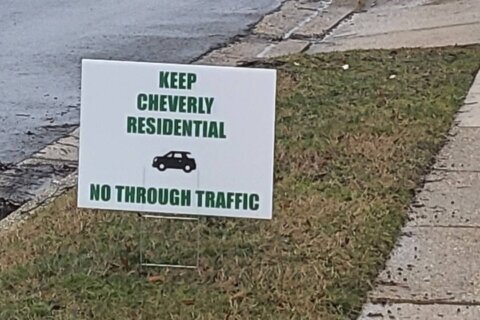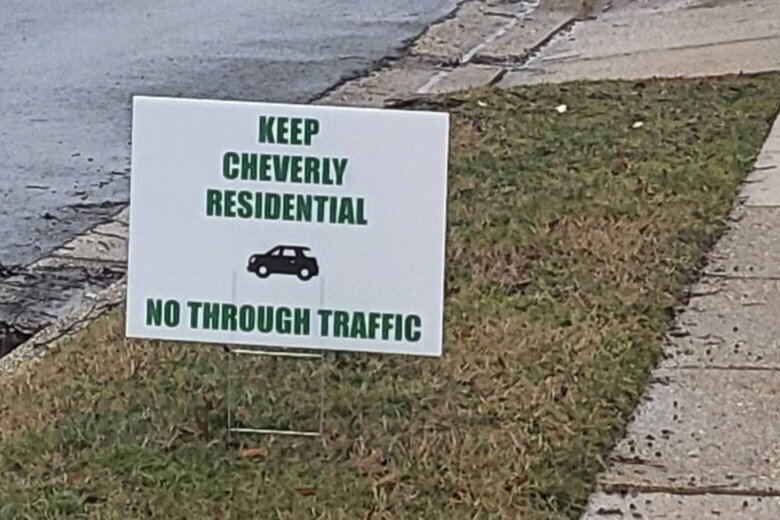
There’s a street fight, of sorts, brewing in the town of Cheverly, Maryland, over the redevelopment of the old Prince George’s Hospital Center. The dispute isn’t over the project itself, which enjoys wide support in the town, but the potential traffic impact on what are now two quiet residential streets.
At the moment, the old hospital property isn’t even in the town of Cheverly, though annexation has been talked about since the project was announced. When the redevelopment project is complete — toward the end of this decade — it’s expected to add thousands of new apartments and town homes, and bring in about eight to 10 new retailers to a town where the 7-Eleven it considered a local coffee shop.
At a meeting Tuesday, developers and town leaders met with residents to talk about where things stand with the project and to discuss the feedback they’ve gotten about the type of retailers that residents want to see there. There was a heavy emphasis on a coffee shop and dining options, with local businesses in other nearby cities mentioned as examples of what residents are seeking.
But at least some residents say there’s one part of the project they strongly disagree with.
Currently, plans call for the new project to connect directly to the town of Cheverly by taking two residential streets that currently come to a dead-end near the property line — Lockwood Road and Inwood Street — and opening up a direct connection into Cheverly that doesn’t exist right now.
Developers say doing that is crucial to getting the retail options residents want.
“We have heard in no uncertain terms now from many retail experts … that in order to say to a retailer, ‘Hey you’re going to benefit from those 3,600 households,’ we have got to have connections directly into the town,” said Caroline Kenney with real estate agency Urban Atlantic. “We’re telling you what we’re hearing from the experts.”
But during a question-and-answer period toward the end of Tuesday’s meeting, resident after resident stood up and explained concerns about the traffic impact of the new development.
“It would be really dangerous for us, because there’s going to be a ton of cars going in and out of the street,” said one 13-year-old named Colin who lives on Lockwood Road. “Then you also have the crazy drivers speeding down the road which would ultimately be one of the biggest problems for us because then we wouldn’t be able to step in the street without being worried.”
Moments later his mother, Liz, also spoke.
“We do enjoy living on our dead-end street and we do gather together frequently. Kids learn to ride bikes. They practice basketball. That would go away,” she said. “We would love to see the bike trail, pedestrian access, all those good things.”
It was pointed out on more than one occasion that when a hospital trauma center operated on the site, residential access was never needed for emergency vehicles since the property is easily accessible from Route 202, Kenilworth Avenue and the Baltimore-Washington Parkway.
“Out of the 74 years I’ve lived here, it was never feasible to make access to the hospital for emergency vehicles,” said another resident who spoke. “Now they want to cut it through for a cup of coffee.”
However another resident named David, who conceded his street would not be impacted by the cut-throughs, said he worried about jeopardizing the very amenities that residents have been craving.
“Making sure we have a successful development that gives us that type of locally focused retail is … a once-in-a-generation type of opportunity, and I hope we don’t miss out on it,” he said.
Also arguing in favor of the cut-throughs was Cheverly resident and Prince George’s County Council Chair Jolene Ivey, who said opening up the streets and then closing them is easier than keeping them closed and deciding you want the connections later. She said a similar decision was made by residents who live near National Harbor, and that now they’ve come to regret it.
“If you don’t build them now and one day you decide to build them it will be impossible to, plus just ridiculously expensive,” Ivey said. “If you build them as part of the project, the town still owns the street, and the town can put a barrier there if it chooses, if it turns out … this wasn’t a great idea. But if you haven’t built the street I think it’s going to be a big mistake.”
She added, “Building it now means it’s built, you have it, and you can always change things.”
This month a survey will go out to Cheverly residents asking them their opinions, and Kenney noted that the results of it will play a big role in guiding the shape of the development going forward.
“Ultimately, it is up to the town how the site connects into the town of Cheverly,” she said. But they hammered home the idea that the decision will ultimately determine how attractive the development will be to any potential retailers.
Get breaking news and daily headlines delivered to your email inbox by signing up here.
© 2024 WTOP. All Rights Reserved. This website is not intended for users located within the European Economic Area.









